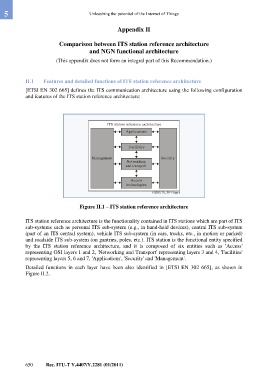Page 664 - Unleashing the potenti al of the Internet of Things
P. 664
5 Unleashing the potential of the Internet of Things
Appendix II
Comparison between ITS station reference architecture
and NGN functional architecture
(This appendix does not form an integral part of this Recommendation.)
II.1 Features and detailed functions of ITS station reference architecture
[ETSI EN 302 665] defines the ITS communication architecture using the following configuration
and features of the ITS station reference architecture:
ITS station reference architecture
Applications
Facilities
Management Security
Networking
and transport
Access
technologies
Y.2281(11)_FII-1-App-II
Figure II.1 – ITS station reference architecture
ITS station reference architecture is the functionality contained in ITS stations which are part of ITS
sub-systems such as personal ITS sub-system (e.g., in hand-held devices), central ITS sub-system
(part of an ITS central system), vehicle ITS sub-system (in cars, trucks, etc., in motion or parked)
and roadside ITS sub-system (on gantries, poles, etc.). ITS station is the functional entity specified
by the ITS station reference architecture, and it is composed of six entities such as 'Access'
representing OSI layers 1 and 2, 'Networking and Transport' representing layers 3 and 4, 'Facilities'
representing layers 5, 6 and 7, 'Applications', 'Security' and 'Management'.
Detailed functions in each layer have been also identified in [ETSI EN 302 665], as shown in
Figure II.2.
650 Rec. ITU-T Y.4407/Y.2281 (01/2011)

